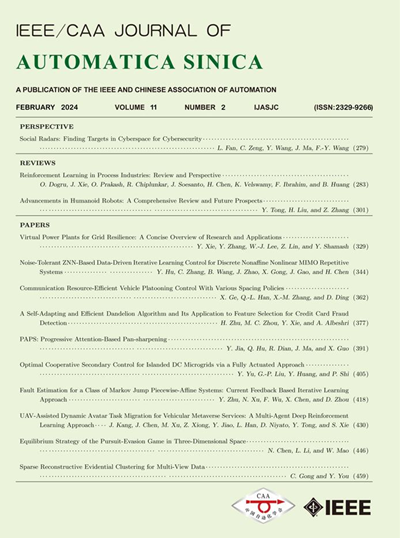Automation 5.0: The Key to Systems Intelligence and Industry 5.0
IF 15.3
1区 计算机科学
Q1 AUTOMATION & CONTROL SYSTEMS
引用次数: 0
Abstract
Automation has come a long way since the early days of mechanization, i.e., the process of working exclusively by hand or using animals to work with machinery. The rise of steam engines and water wheels represented the first generation of industry, which is now called Industry 1.0. Subsequently, Industry 2.0 witnessed the development of electric power and assembly lines. Later on, programmable logic controllers and Human Machine Interfaces (HMI) were the new productivity tools in Industry 3.0, which enabled precise and consistent production. In recent years, Industry 4.0 absorbed the latest technologies of Internet of Things (IoT), Artificial Intelligence (AI), and big data, making production processes integrated, interconnected, and smart. Nowadays, Industry 5.0 has been proposed, which emphasizes human-centric automation. Specifically, the new concept of automation in Industry 5.0, named Automation 5.0, is no longer about how to create machinery to replace humans. Instead, it aims to reach organic interactions and cooperation between humans and machines, meeting the goal of “6S” - Safety, Security, Sustainability, Sensitivity, Service, and Smartness [1]–[4] - and the overall objective of deploying automation for the better, human-friendly, and smarter industry.自动化 5.0:系统智能和工业 5.0 的关键
自早期的机械化(即完全依靠手工或使用动物与机械配合工作的过程)以来,自动化已经走过了漫长的道路。蒸汽机和水轮的兴起代表了第一代工业,即现在的工业 1.0。随后,工业 2.0 见证了电力和装配线的发展。后来,可编程逻辑控制器和人机界面(HMI)成为工业 3.0 的新生产力工具,实现了精确和稳定的生产。近年来,工业 4.0 吸收了物联网(IoT)、人工智能(AI)和大数据等最新技术,使生产过程集成化、互联化和智能化。如今又提出了工业 5.0,强调以人为本的自动化。具体来说,工业 5.0 的自动化新概念被命名为 "自动化 5.0",它不再是如何创造机械来取代人类。相反,它旨在实现人与机器之间的有机互动与合作,达到 "6S "目标--安全(Safety)、安保(Security)、可持续发展(Sustainability)、灵敏(Sensitivity)、服务(Service)和智能(Smartness)[1]-[4]--以及部署自动化以实现更美好、更人性化和更智能的工业的总体目标。
本文章由计算机程序翻译,如有差异,请以英文原文为准。
求助全文
约1分钟内获得全文
求助全文
来源期刊

Ieee-Caa Journal of Automatica Sinica
Engineering-Control and Systems Engineering
CiteScore
23.50
自引率
11.00%
发文量
880
期刊介绍:
The IEEE/CAA Journal of Automatica Sinica is a reputable journal that publishes high-quality papers in English on original theoretical/experimental research and development in the field of automation. The journal covers a wide range of topics including automatic control, artificial intelligence and intelligent control, systems theory and engineering, pattern recognition and intelligent systems, automation engineering and applications, information processing and information systems, network-based automation, robotics, sensing and measurement, and navigation, guidance, and control.
Additionally, the journal is abstracted/indexed in several prominent databases including SCIE (Science Citation Index Expanded), EI (Engineering Index), Inspec, Scopus, SCImago, DBLP, CNKI (China National Knowledge Infrastructure), CSCD (Chinese Science Citation Database), and IEEE Xplore.
 求助内容:
求助内容: 应助结果提醒方式:
应助结果提醒方式:


